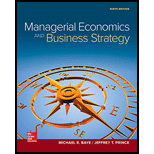
(a)
To find:
The total benefit when Qis 2 and when Qis 10.
Answer to Problem 9CACQ
When Qis 2, total benefit is 32 and when Qis 10, the total benefit is 0.
Explanation of Solution
Use the given equation,
Total Benefit is given by,
When Quantity, Qis 2, total benefit will be,
Thus, when Quantity is 2, total benefit is 32.
When quantity ( Q ) is 10, total benefit is as follows:
Thus, when Qis 10, the total benefit is 0.
Total benefit:
Total benefit refers to the total satisfaction a consumer can get after consumption. It can also be the maximum amount that a consumer will pay to get a commodity or service.
(b)
To compute:
The marginal benefit when Qis 2 and Qis 10.
Answer to Problem 9CACQ
When Qis 2, marginal benefit is 12 and when Qis 10, the marginal benefit is -20.
Explanation of Solution
Use the given equation, marginal benefit is as follows:
When Qis 2, marginal benefit is as follows:
Thus, if Qis 2, marginal benefit is 12 and when Qis 10, marginal benefit is as follows:
Thus, if Qis 10, the marginal benefit is -20.
Marginal benefit:
Marginal benefit is the addition to total benefit when an additional unit of good is consumed.
(c)
To find:
The level of Q that maximizes total benefit
Answer to Problem 9CACQ
When Qis 5, total benefits are maximum.
Explanation of Solution
Total benefit is given by the equation,
Taking the derivative of B( Q ) and setting it equal to zero gives,
Thus, when Qis 5, total benefits are maximum. To verify that, second derivative should be negative.
Therefore, at Qis 5, total benefits are maximum.
Total benefit:
Total benefit refers to the total satisfaction a consumer can get after consumption. It can also be the maximum amount that a consumer will pay to get a commodity or service.
(d)
To compute:
The total cost when Qis2 and when Q is 10.
Answer to Problem 9CACQ
When Qis 2, the total cost is $12 and when Q = 10, total cost is $204.
Explanation of Solution
Total cost is the
When Q is 2,
Thus, when Qis 2, the total cost is 12.
When Q = 10, total cost will be,
Thus, when Qis 10, total cost is 204.
Total cost:
Total cost is the total amount incurred in production of goods or services.
(e)
To find:
The marginal cost when Qis 2 and when Q is 10.
Answer to Problem 9CACQ
When Qis 2, the marginal cost is 8 and when Qis 10, the marginal cost is 40.
Explanation of Solution
Marginal Cost
When Qis 2, marginal cost is as follows:
When Qis 10, marginal cost is as follows:
Thus, if Qis 10, the marginal cost is 40.
Marginal cost:
Marginal cost is the addition to total cost when an additional unit is produced.
(f)
To find:
The level of Q which minimizes cost.
Answer to Problem 9CACQ
When Q = 0, the cost is minimum.
Explanation of Solution
Total cost is,
Taking the derivative and setting it to zero,
To verify that it is minimum, check that the second derivative is positive,
Therefore, at Qis 0 total cost is minimum.
Total cost:
Total cost is the total amount incurred in production of goods or services.
(g)
To find:
The level of Q which maximizes net benefits.
Answer to Problem 9CACQ
Net benefits will be maximum when Qis 2.5.
Explanation of Solution
Since,
And,
For the maximum net benefits, it follows that,
Thus, the net benefits will be maximum when Qis 2.5
Net benefits:
The net benefits are the maximum at that level of control variable ( Q ) where the marginal benefits are equal to the marginal costs. The following condition equation is used for maximum net benefits:
Where,
MB( Q ) ismarginal benefits, and
MC( Q ) is marginal costs.
Want to see more full solutions like this?
Chapter 1 Solutions
Managerial Economics & Business Strategy (Mcgraw-hill Series Economics)
- how commond economies relate to principle Of Economics ?arrow_forwardCritically analyse the five (5) characteristics of Ubuntu and provide examples of how they apply to the National Health Insurance (NHI) in South Africa.arrow_forwardCritically analyse the five (5) characteristics of Ubuntu and provide examples of how they apply to the National Health Insurance (NHI) in South Africa.arrow_forward
- Outline the nine (9) consumer rights as specified in the Consumer Rights Act in South Africa.arrow_forwardIn what ways could you show the attractiveness of Philippines in the form of videos/campaigns to foreign investors? Cite 10 examples.arrow_forwardExplain the following terms and provide an example for each term: • Corruption • Fraud • Briberyarrow_forward
- In what ways could you show the attractiveness of a country in the form of videos/campaigns?arrow_forwardWith the VBS scenario in mind, debate with your own words the view that stakeholders are the primary reason why business ethics must be implemented.arrow_forwardThe unethical decisions taken by the VBS management affected the lives of many of their clients who trusted their business and services You are appointed as an ethics officer at Tyme Bank. Advise the management regarding the role of legislation in South Africa in providing the legal framework for business operations.arrow_forward




 Managerial Economics: A Problem Solving ApproachEconomicsISBN:9781337106665Author:Luke M. Froeb, Brian T. McCann, Michael R. Ward, Mike ShorPublisher:Cengage Learning
Managerial Economics: A Problem Solving ApproachEconomicsISBN:9781337106665Author:Luke M. Froeb, Brian T. McCann, Michael R. Ward, Mike ShorPublisher:Cengage Learning Exploring EconomicsEconomicsISBN:9781544336329Author:Robert L. SextonPublisher:SAGE Publications, Inc
Exploring EconomicsEconomicsISBN:9781544336329Author:Robert L. SextonPublisher:SAGE Publications, Inc





